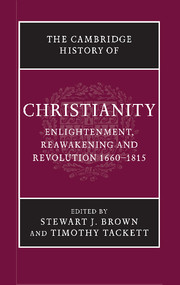Book contents
- Frontmatter
- Introduction
- PART I CHURCH, STATE, AND SOCIETY IN THE EUROPEAN WORLD, 1660–1780
- PART II CHRISTIAN LIFE IN THE EUROPEAN WORLD, 1660–1780
- PART III MOVEMENTS AND CHALLENGES
- PART IV CHRISTIAN DEVELOPMENTS IN THE NON-EUROPEAN WORLD
- PART V REVOLUTION AND THE CHRISTIAN WORLD
- 25 The American Revolution and religion, 1765–1815
- 26 Christianity and the campaign against slavery and the slave trade
- 27 The French Revolution and religion to 1794
- 28 The French Revolution and religion, 1795–1815
- 29 Movements of Christian awakening in revolutionary Europe, 1790–1815
- Chronology
- Bibliography
- Index
- References
29 - Movements of Christian awakening in revolutionary Europe, 1790–1815
from PART V - REVOLUTION AND THE CHRISTIAN WORLD
Published online by Cambridge University Press: 28 March 2008
- Frontmatter
- Introduction
- PART I CHURCH, STATE, AND SOCIETY IN THE EUROPEAN WORLD, 1660–1780
- PART II CHRISTIAN LIFE IN THE EUROPEAN WORLD, 1660–1780
- PART III MOVEMENTS AND CHALLENGES
- PART IV CHRISTIAN DEVELOPMENTS IN THE NON-EUROPEAN WORLD
- PART V REVOLUTION AND THE CHRISTIAN WORLD
- 25 The American Revolution and religion, 1765–1815
- 26 Christianity and the campaign against slavery and the slave trade
- 27 The French Revolution and religion to 1794
- 28 The French Revolution and religion, 1795–1815
- 29 Movements of Christian awakening in revolutionary Europe, 1790–1815
- Chronology
- Bibliography
- Index
- References
Summary
On 10 September 1815, Tsar Alexander I of Russia held a review of his army to celebrate the final allied victory over Napoleonic France. Over 150,000 soldiers assembled on the Plain of Vertus, a vast natural amphitheatre located some eighty miles east of Paris. Amid glorious late summer weather, the troops conducted elaborate manoeuvres, punctuated by the sound of 540 cannon, in the presence of the Tsar and his brother sovereigns, the Emperor of Austria and the King of Prussia. Seated in a court barouche near the Tsar, dressed in a blue serge dress and straw hat, was Julie, Baroness de Krüdener. Informal spiritual advisor to the Tsar and self-proclaimed prophetess, the Baroness was, in the words of the French Protestant author, Madame de Stäel, ‘the forerunner of a great religious epoch which is dawning for the human race’. On the following day, the feast day of St Alexander Nevsky, 150,000 soldiers celebrated Mass on the plain, organized into seven squares before seven altars. In describing the event, Baroness de Krüdener was ecstatic. ‘I saw at the head of the army’, she observed of the Tsar, ‘the man of great destinies, the man prepared before the ages and for the ages. The Eternal had summoned Alexander and, obediently, Alexander had answered the call of the Eternal.’ Fifteen days later, the sovereigns of Russia, Austria, and Prussia signed a document, largely drafted by Alexander, which would become known as the ‘Holy Alliance’. By this, they solemnly pledged to govern their lands and conduct their mutual relations in accordance with ‘the sublime truths which the Holy Religion of our Saviour teaches’.
- Type
- Chapter
- Information
- The Cambridge History of Christianity , pp. 575 - 595Publisher: Cambridge University PressPrint publication year: 2006
References
- 1
- Cited by

